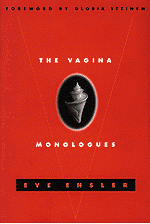

|

"Vagina." Not A Word You Want To Say.
By Mari Wadsworth
EVE ENSLER IS right. No matter how may times you say it,
it doesn't sound like a word you want to say. "It's scary
saying the word," writes the award-winning playwright, poet,
screenwriter, activist and performance artist: " 'Vagina.'
At first it feels like you're crashing through an invisible wall.
'Vagina.' You feel guilty and wrong, as if someone's going to
strike you down...(Then) you say it with a kind of passion, a
kind of urgency, because you sense that if you stop saying it,
the fear will overcome you again and you will fall back into an
embarrassed whisper...."
 But Ensler's intriguing work, a compilation of more than 14 essaying
monologues, is more than an exercise in semantics. It's an Obie
Award-winning one-woman show translated to book form; a chronicle
of more than 200 interviews with females ranging in age from 6
to 75, answering questions like, "If your vagina got dressed,
what would it wear?" (a leather jacket, emeralds, a large
hat full of flowers, purple velvet pajamas, a slicker, something
machine-washable...); "If your vagina could talk, what
would it say?" (Is that you? Brave choice. Not yet. Enter
at your own risk. Don't give up. Find me.)
But Ensler's intriguing work, a compilation of more than 14 essaying
monologues, is more than an exercise in semantics. It's an Obie
Award-winning one-woman show translated to book form; a chronicle
of more than 200 interviews with females ranging in age from 6
to 75, answering questions like, "If your vagina got dressed,
what would it wear?" (a leather jacket, emeralds, a large
hat full of flowers, purple velvet pajamas, a slicker, something
machine-washable...); "If your vagina could talk, what
would it say?" (Is that you? Brave choice. Not yet. Enter
at your own risk. Don't give up. Find me.)
It catalogs the things we call them: "In Westchester they
called it a pooki, in New Jersey a twat. There's powderbox, derrière,
poochi, peepe, poopelu...toadie, nishi, dignity, monkey box, coochi
snorcher, fannyboo, mushmellow, Gladys Siegelman, tamale, tottita,
Connie, a 'Mimi' in Miami, 'split knish' in Philadelphia, and
'schmende' in the Bronx. I am worried about vaginas," she
writes.
 With skilled observation, uncensored description and playful
humor, she translates trusted personal anecdotes into a telling
mosaic of collective beliefs about women's bodies. From a 6-year-old
girl's secret that somewhere deep inside her vagina she knows
"it has a really, really smart brain," to the broken,
horrific tales Ensler captures in "My Vagina Was My Village,"
an homage to the Bosnian rape-camp victims she interviewed, the
author recaptures and reclaims not only an anatomy that's terra
incognita to many, but the language we use to discuss it: old,
young, married, single, gay, scholarly, sex industry, corporate,
Asian, African American, Hispanic, Native, Caucasian, Jewish.
She talks about myth and symbolism. ("The shape we call a
heart," writes Gloria Steinem in her forward, "whose
symmetry resembles the vulva far more than the asymmetry of the
organ that shares its name, is probably a residual female genital
symbol. (Such symbols) were reduced from power to romance by centuries
of male dominance.") Aw, shucks. Just in time for Valentine's
Day.
With skilled observation, uncensored description and playful
humor, she translates trusted personal anecdotes into a telling
mosaic of collective beliefs about women's bodies. From a 6-year-old
girl's secret that somewhere deep inside her vagina she knows
"it has a really, really smart brain," to the broken,
horrific tales Ensler captures in "My Vagina Was My Village,"
an homage to the Bosnian rape-camp victims she interviewed, the
author recaptures and reclaims not only an anatomy that's terra
incognita to many, but the language we use to discuss it: old,
young, married, single, gay, scholarly, sex industry, corporate,
Asian, African American, Hispanic, Native, Caucasian, Jewish.
She talks about myth and symbolism. ("The shape we call a
heart," writes Gloria Steinem in her forward, "whose
symmetry resembles the vulva far more than the asymmetry of the
organ that shares its name, is probably a residual female genital
symbol. (Such symbols) were reduced from power to romance by centuries
of male dominance.") Aw, shucks. Just in time for Valentine's
Day.
"I bet you're worried," writes Ensler. "I
was worried. That's why I began this piece. I was worried about
vaginas. I was worried what we think about vaginas, and even more
worried that we don't think about them...There's so much darkness
and secrecy surrounding them--like the Bermuda Triangle. Nobody
ever reports back from there." At ease, central command (or
"at attention" is probably more like it). Ensler has
re-emerged with flying colors--perhaps the first woman to break
the vagina sound barrier.

|
 |





